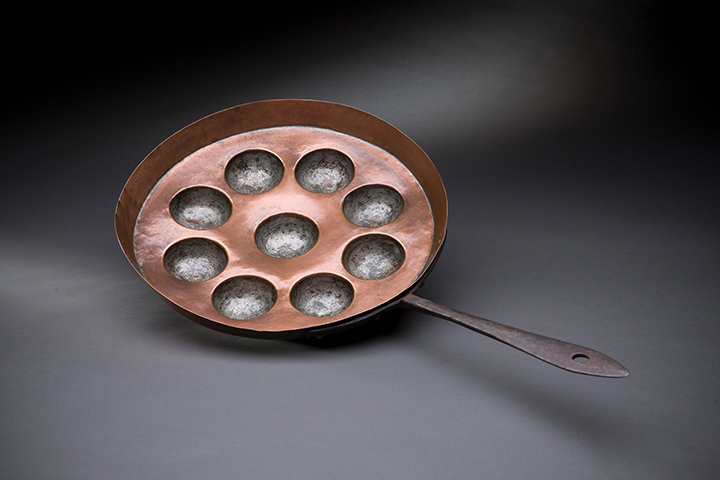OBJECT SPOTLIGHT

Dutch Treat
A recently acquired copper pan may have elevated the humble pancake at Mount Vernon
Dictionary writer Noah Webster was a master of vocabulary. Yet a delicacy from Martha Washington’s kitchen left him nearly at a loss for words. As he later recalled of his visit to Mount Vernon in 1785, “At dinner the last course of dishes was a species of pancakes which were handed around to each guest, accompanied with a bowl of sugar and another of molasses for seasoning them….”
What was this nameless “species of pancakes”? A copper cooking pan, recently acquired with the landmark Peter Family Collection, may unlock the mystery.
The pan is shallow, with nine tin-lined circular depressions. After Martha Washington’s death in 1802, the pan traveled with other kitchenwares to Tudor Place, the home of Martha’s granddaughter Martha (Patty) Parke Custis Peter in Washington, D.C. Later family owners identified it as “a muffin pan for nine muffins” or a “copper egg poacher.”
Recent research, however, points to a different, more specialized identity—a poffertjes pan. Dutch foodways historian Peter G. Rose describes these pastries as “tiny puffed pancakes, made in a special pan with indentations.” Starting with a batter of milk, buckwheat, and yeast, poffertjes feature a puffy, lighter texture more akin to French crèpes than American pancakes and are typically served with powdered sugar and butter. Modern cooks still make these traditional Dutch treats today.
How did a Dutch poffertjes pan make its way to Virginia? Was it a gift from a Dutch family the Washingtons visited while headquartered in the Hudson River Valley in the last years of the Revolutionary War? Did a traditional family recipe come with the pan? Would Mount Vernon’s enslaved cooks—Doll, Lucy, Nathan, Hercules—have been excited or exasperated at having to try a new recipe? Would they have been surprised to see this pan return, more than two hundred years later?
Discover more objects in the Mount Vernon collection at emuseum.mountvernon.org.